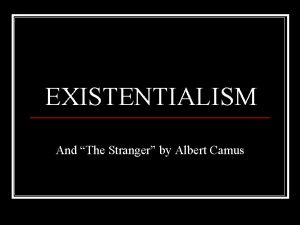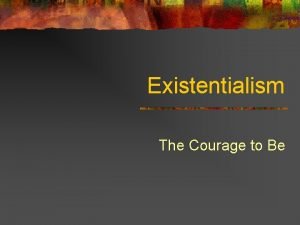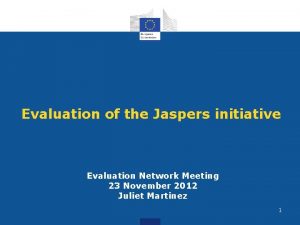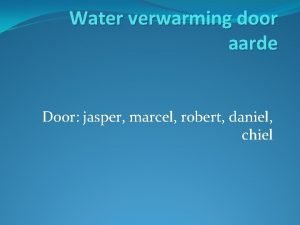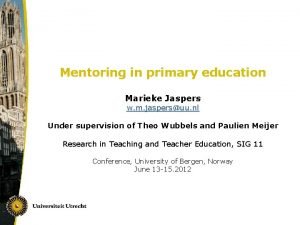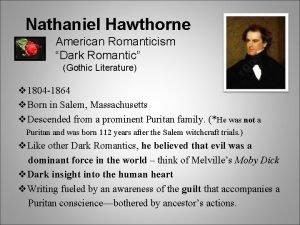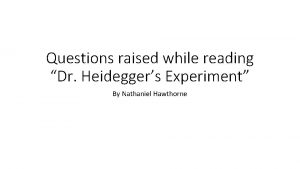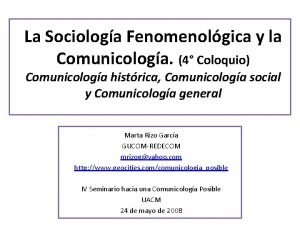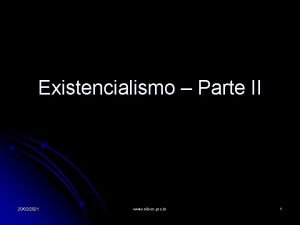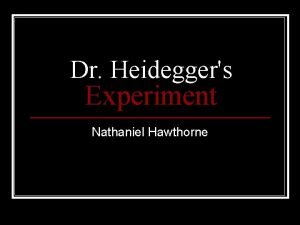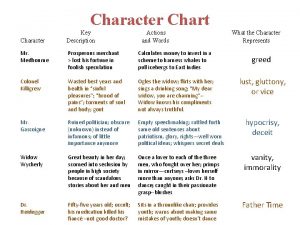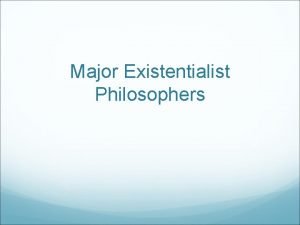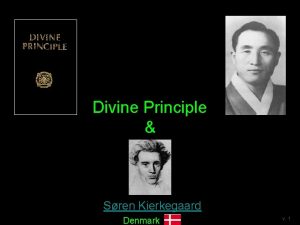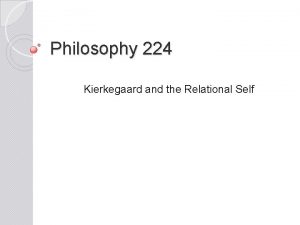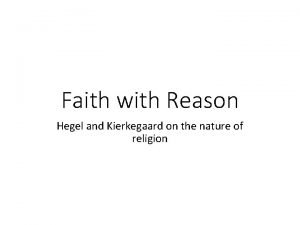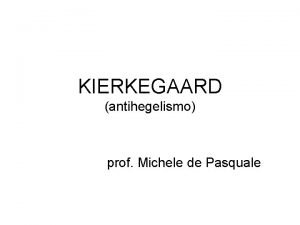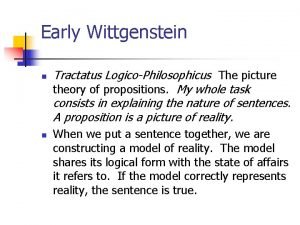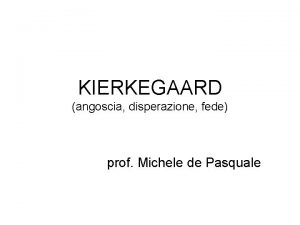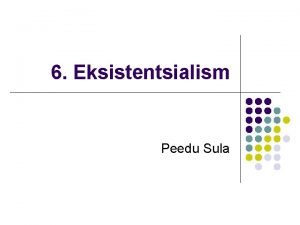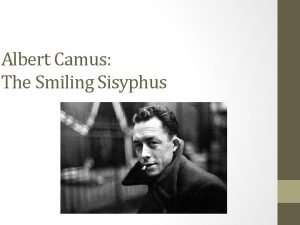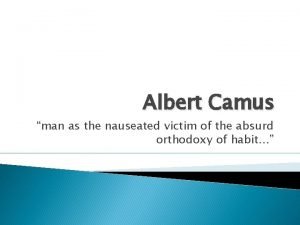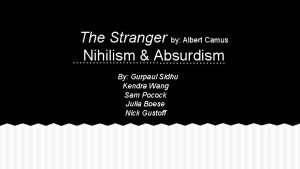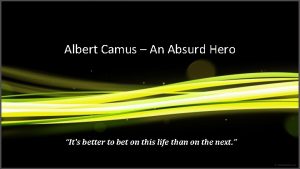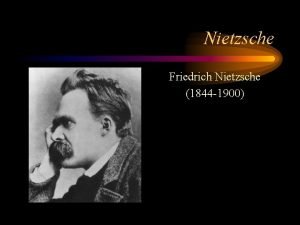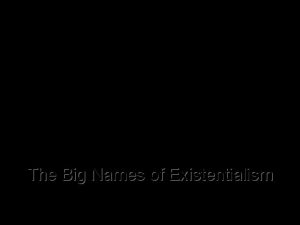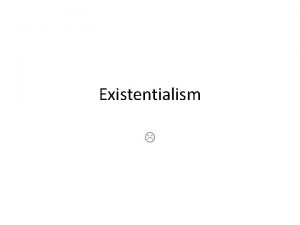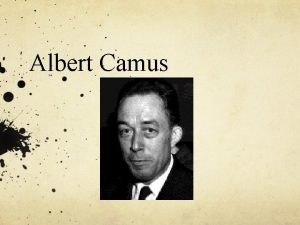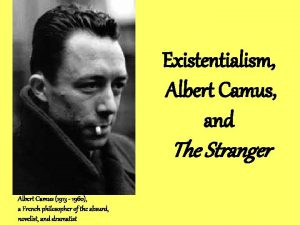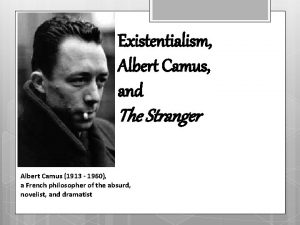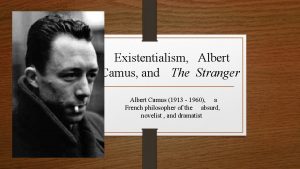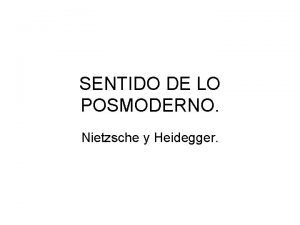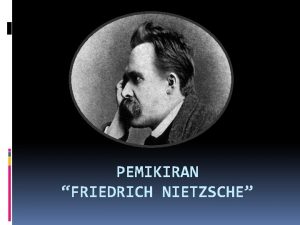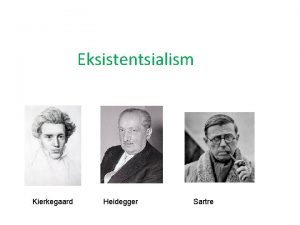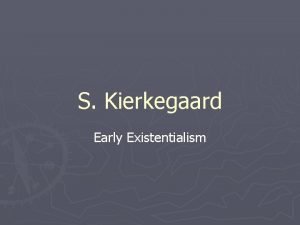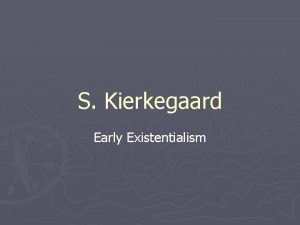EXISTENTIALISM Existential thinkers Kierkegaard Nietzsche Camus Jaspers Heidegger


































- Slides: 34

EXISTENTIALISM • Existential thinkers: Kierkegaard, Nietzsche, Camus, Jaspers, Heidegger and Sartre. • Kierkegaard’s existential conception of subjectivity • Nietzsche’s existential conception of the will to power • Jaspers’s existential conception of transcendence • Heidegger's existential analysis of Dasein • Sartre’s existentialism • Main topics: existence, meaning and meaninglessness, freedom, anxiety (Angst), death, and human sociability. • “Existence precedes essence” / the individual vs. the crowd / the impersonal/ institutions: Existential Ethics

Heidegger’s Critique of Traditional Metaphysics // Kant’s • general metaphysics (ontology = the study of beings, "ta onta, " in Greek) • special metaphysics: • 1. theology = study of god (theos), or the first mover, the ground of being • 2. anthropology = the study of human being (anthropos) and psychology = the study of the soul (psyche) as the active principle of living beings, particularly human beings • 3. cosmology = the study of the cosmos (kosmos), the universe, the whole or totality of all beings

Heidegger’s Hermeneutic Phenomenology (Sein und Zeit, 1927) • Only as phenomenology is ontology possible: a study of Dasein’s modes of Being-in-the-world. • Phenomenology is hermeneutic: Dasein’s praxis of historical self-interpretation/theoria (presenceat-hand) and poiesis (readiness-to-hand) • Existential phenomenology: letting “that which shows itself be seen from itself in the very way in which it shows itself from itself”/ environmentality • Phenomenology remains thus “the possibility of thinking. . . corresponding to the claim of what is to be thought, ” an ontology of the futural present

Heidegger: “existence precedes essence” • The question of the meaning of Being (Seinsfrage), in order to deal with its forgetfulness (Vergessenheit), must be reformulated: the ontical-ontological difference (ontisch-ontologische Differenz): Sein (Being) / Seienden (beings, entities) : : ontological / ontical • Being-in-the-World as the basic state of Dasein / subject-object dichotomy / present-at-hand (vorhanden) / ready-to-hand (zuhanden) • Authenticity (Eigentlichkeit) does not require the emergence of a thematically conscious subject

Sartre, Existentialism is a Humanism (L'existentialisme est un humanisme, 1946) • In any case, we can begin by saying that existentialism, in our sense of the word, is a doctrine that does render human life possible; a doctrine, also, which affirms that every truth and every action imply both an environment and a human subjectivity. • Man first of all exists, encounters himself, surges up in the world - and defines himself afterwards.

Being and Nothingness (L’être et le néant, 1943) • in-itself (en soi) vs. for-itself (pour soi) • beings / facticity / things (rocks) vs. consciousness / negation • Das Nichts nichtet (Nothingness nothings) • abstract (form) vs. concrete (spatialtemporal thing / determination) • 1) Being-in-the-world / synthetic • 2) man and world / human conduct

Being and Non-Being • That about which I question the being participates in the transcendence of being. • Thus the question is a bridge set up between two non-beings: the non-being of knowing in man, the possibility of nonbeing of being in transcendent being. • Whatever being is, it will allow this formulation: “Being is that and outside of that, nothing. ”

Negations • • • Not only an act of judgment (comparison) “X is not” / “as tall as Y” “The café is a fullness of being” “. . . But now Pierre is not here. ” It is the negative judgment which is conditioned and supported by non-being. • Every determination is negation (Hegel) • Dialectics of “surpassing” (aufheben): • To negate / preserve / uplift

Nothingness haunts Being • That means that being has no need of nothingness in order to be conceived and that we can examine the idea of it exhaustively without finding there the least trace of nothingness. • Being is prior to nothingness and establishes the ground for it. • Non-being exists only on the surface of being.

The Phenomenological Concept of Nothingness • Heidegger, “What is Metaphysics? ” (1929) • “Nothing” is more original than the Not and negation: Dread (Angst) reveals Nothing. • Nothing nothings … Da-sein means being projected into Nothing (das Nichts) • Da-sein is already beyond what-is-intotality: Transcendence … Freedom • Why is there any being at all rather than nothing?

Sartre’s Critique of Heidegger • Being and non-being are no abstractions • Doesn’t Heidegger’s concept of Dasein as surpassing toward itself remain dialectic? • Dasein is not in itself, not being the world • If negation is the original structure of transcendence, what must be the original structure of “human reality” in order for it to transcend the world? (negating activity)

• Heidegger makes of Nothingness a sort of intentional correlate of transcendence without seeing that he has already inserted it into transcendence itself as its original structure • Negation is not reducible to a judgment • Négatités : types of syntheses of negative and positive in which negation is the condition of positivity (like Kant’s regulative ideas, esp. freedom)

The Origin of Nothingness • Nothingness lies coiled in the heart of being – like a worm. • If Nothingness can be conceived neither outside of Being, nor in terms of Being, and since it is non-being, it can not derive from itself the necessary force to nihilate itself, where does Nothingness come from? • Since Nothingness is not, it can not nihilate itself but “is nihilated. ”

Freedom and Nothingness • The being by which Nothingness comes to the world must be its own Nothingness. • Not a nihilating act, but an ontological characteristic of the Being required. • Man is the being through whom nothingness comes to the world. • Human freedom precedes essence in man and makes it possible

• Every psychic process of nihilation implies a cleavage between the immediate psychic past and the present. This cleavage is precisely nothingness. • Freedom is the human being putting his past out of play by secreting his own nothingness …if freedom is the being of consciousness, consciousness must exist as the consciousness of freedom. • It is in anguish that one gets conscious of one’s freedom, in question for itself.

Vertigo and Nothingness • Kierkegaard: Angst (angoisse, dread) entails Freedom. • Vertigo: anguish before the possibility of throwing myself over the precipice, as nothing prevents me from doing so • Anguish=the recognition of a possibility as my possibility • Ethical anguish: my freedom is the unique foundation of values and nothing else – no last foundation for values. • Anguish is the reflective apprehension of freedom by itself; the comprehension of a possible as my possible. • The foundation of all negation lies in a nihilation exercised in the very heart of immanence (pure subjectivity): we are our own nothingness.

Bad Faith • Mauvaise foi : self-deception, self-negation • The human being is not only the being by whom négatités are disclosed in the world; • he is also the one who can take negative attitudes with respect to himself. • Consciousness = a being whose nature is to be conscious of the nothingness of its being…My consciousness is not restricted to envisioning a négatité.

Bad Faith and Falsehood • Self-denial: “the man of resentment” (Scheler) / “resignation” (Nietzsche) • It doesn’t come from the outside; one does not undergo her bad faith: it is not a state • Evanescence of bad faith which vacillates between good faith and cynicism • Critique of Freudian psychoanalysis • Decadence: psychological, moral, aesthetic self-deception (Nietzsche)

Patterns of Bad Faith • Human being is at once a facticity and a transcendence; bad faith seeks to affirm their identity & preserve their differences by denying what they are & their synthesis • Bad faith cannot be good faith / cynical lie • Human reality: a being which is what it is not and which is not what it is. • Hence one’s attempt to escape the responsible freedom of Being-for-itself

Being and Bad Faith • How can we humans be what we are when we exist as consciousness of being? • What a human being is can not be posited as a question of identity (in-itself). • The waiter in the café (role-playing): he denies his total freedom, and chooses instead to behave as an inert object (an in-itself, transcendent, as an inkwell is an inkwell). • The Other’s consciousness is what it is not.

The “Faith” of Bad Faith • The true problem of bad faith stems evidently from the fact that bad faith is faith. It can not be either a cynical lie or certainty …it is a problem of belief. • Consciousness is always consciousness of something and at the same time nonpositional consciousness of itself. • Heidegger’s transcendence is bad faith: We encounter the Other, we do not constitute him

Bad faith = not-being-what-one-is • If bad faith is possible, it is because it is an immediate, permanent threat to every project of the human being; • It is because consciousness conceals in its being a permanent risk of bad faith. • The origin of this risk is the fact that the nature of consciousness simultaneously is to be what it is not and not to be what it is.

Consciousness: Being and Nothingness • Consciousness is a being whose existence posits essence; • It is consciousness of a being, whose essence implies its existence; that is, in which appearance lays claim to being. • Consciousness is a being such that in its being, its being is in question in so far as this being implies a being other than itself. • Conscious of the nothingness of its being.

Being and Nothingness (L’être et le néant, 1943) • • Introduction: The Pursuit of Being Part I : The Problem of Nothingness Ch. 1: The Origin of Negation Ch. 2: Bad Faith Part II : Being-for-Itself Part III : Being-for-Others Solipsism / Hegel, Husserl, Heidegger Part IV : Having, Doing, and Being

Being-for-Itself: Immediate Structures of the For-Itself • Presence to Self: Negation → Freedom → Bad Faith → Being of Consciousness • Pre-Reflective Cogito • Being of Consciousness does not coincide with itself in a full equivalence (in-itself) • “A is A” (principle of identity) • If being is present to itself, it is because it is not wholly itself – “fissure”

The Facticity of the For-Itself • Human reality is being in so far as within its being and for its being it is the unique foundation of nothingness at the heart of being. • The for-itself is insofar as it is thrown into a world and abandoned in a “situation. ” • Being is the foundation of nothingness as the nihilation of its being --not foundation of its being • God, if he exists, is contingent.

Being there for nothing: de trop • The for-itself is necessary in so far as it provides its own foundation. • Being-itself can found its nothingness but not its being. • It is what remains of the in-itself in the foritself as facticity and what causes the foritself to have only a factual necessity: • It is the foundation of its consciousness-ofbeing or existence

Part III : Being-for-Others • • Chapter 1: The Existence of Others I. The Problem II. The Reef of Solipsism III. Hegel, Husserl, Heidegger IV. The Look Chapter 2: The Body Chapter 3: Concrete Relations with Others

The Problem of the Existence of Others • Human Reality is-for-itself, both from the standpoint of negating conduct and Cogito • This ontological structure is mine, this concern for myself reveals to me a being which is my being without being-for-me. • Shame: nonpositional self-consciousness, conscious of itself, a lived experience (Erlebnis) accessible to reflection: I am ashamed of myself as I appear to the Other (nobody can be vulgar all alone) • Shame is by nature recognition = before the Other

The Reef of Solipsism • Kantian idealism: transcendental subject • Leibniz: pre-established harmony • The concept of the Other can not constitute our experience • Others are the Other, that is the self which is not myself • The recourse to God is simply a recourse to the negation of interiority

Hegel, Husserl, Heidegger • 19 th and 20 th cent. attempts to overcome solipsism: yet my connection with the Other is realized through knowledge • Husserl: Other ↔ constitution of a world • A critique of the Transcendental Ego insufficient to refute solipsism // Kant • Transcendental consciousness is affected by the extra-mundane existence of other consciousness of the same type

G. W. Hegel, Phenomenology of the Spirit (1807) • As self-consciousness, the Self itself apprehends itself: “Myself=Myself, ” “I am I” • Self-consciousness is recognized in another self-consciousness: the Other as mediator, no longer posited in terms of the Cogito but rendering it possible • Slave-Master Dialectics: the slave is the truth of the master; self-consciousness needs recognition in an Other to be real

M. Heidegger, Being and Time (1927) • Dasein ↔ World : finitude & understanding • Dasein ↔ Being-in-the-World : Mit-Sein • I am responsible for my being with the Other as I realize myself freely in authentic (resolute) or inauthentic (anonymous they) • Heidegger’s difficult transition from the ontological to the ontical experience of transcendence (bad faith): We encounter the Other, we do not constitute him

The existence of others (against solipsism) 1. The Other’s existence can not be a probability (can’t be validated/invalidated) 2. The only point of departure possible is the Cartesian Cogito (the Other’s existence) 3. What the Cogito must reveal to us is not the-Other-as-object (i. e. , neither a representation nor a system) 4. No totalitarian and unifying synthesis of Others is possible (detotalized totality)
 Existentialism in the stranger
Existentialism in the stranger Nietzsche existentialism
Nietzsche existentialism Marieke jaspers
Marieke jaspers Kjk oldenburg
Kjk oldenburg Jaspers verwarming
Jaspers verwarming Marieke jaspers
Marieke jaspers Dark romanticism in young goodman brown
Dark romanticism in young goodman brown What does the water symbolize in dr heidegger's experiment
What does the water symbolize in dr heidegger's experiment Etnometodología
Etnometodología Heidegger
Heidegger Colonel killigrew traits
Colonel killigrew traits Pourquoi y a t il quelque chose plutôt que rien heidegger
Pourquoi y a t il quelque chose plutôt que rien heidegger Colonel killigrew character traits
Colonel killigrew character traits Der feldweg heidegger
Der feldweg heidegger Major existentialist philosophers
Major existentialist philosophers Elvira kierkegaard
Elvira kierkegaard Kierkegaard
Kierkegaard Kierkegaard ppt
Kierkegaard ppt Sren kierkegaard
Sren kierkegaard Urlo di munch collegamenti maturità
Urlo di munch collegamenti maturità Filosofo danese
Filosofo danese Kierkegaard antihegelismo
Kierkegaard antihegelismo Antihegelismo kierkegaard
Antihegelismo kierkegaard Taani filosoof 1813-1855
Taani filosoof 1813-1855 Kierkegaard punti fondamentali
Kierkegaard punti fondamentali Language game theory
Language game theory Disperazione in kierkegaard
Disperazione in kierkegaard Kierkegaard
Kierkegaard Epitaffio tomba kierkegaard
Epitaffio tomba kierkegaard Albert camus smiling
Albert camus smiling Albert camus de vreemdeling
Albert camus de vreemdeling Nausea camus
Nausea camus Absurdism vs nihilism
Absurdism vs nihilism Nagel absurd
Nagel absurd What is an absurd hero
What is an absurd hero
